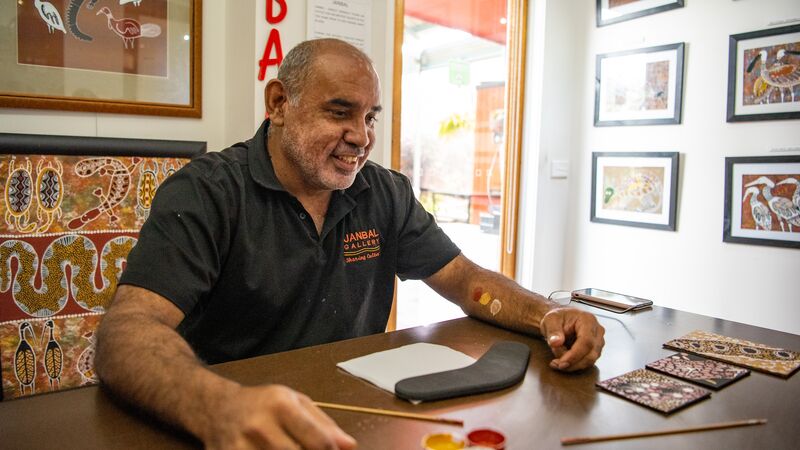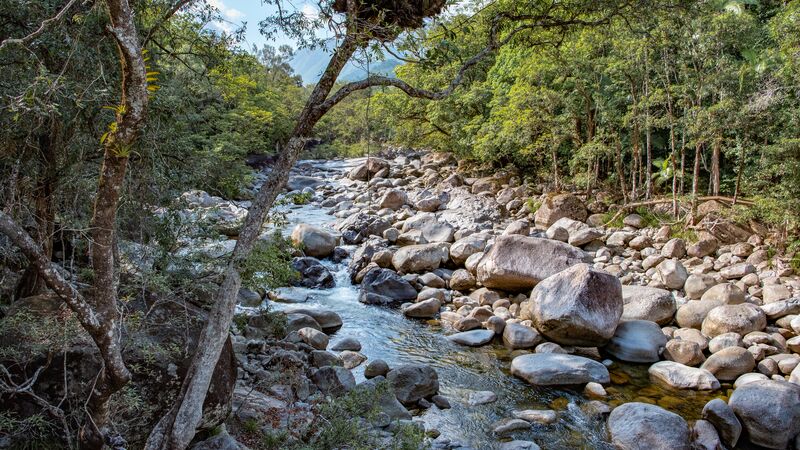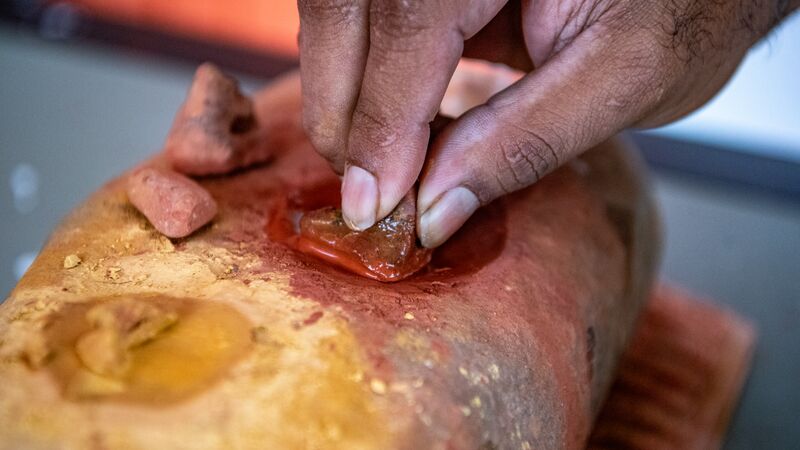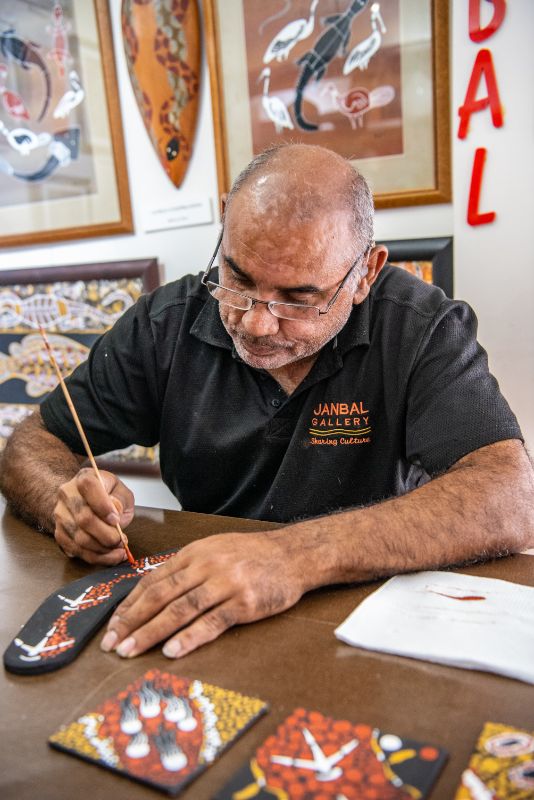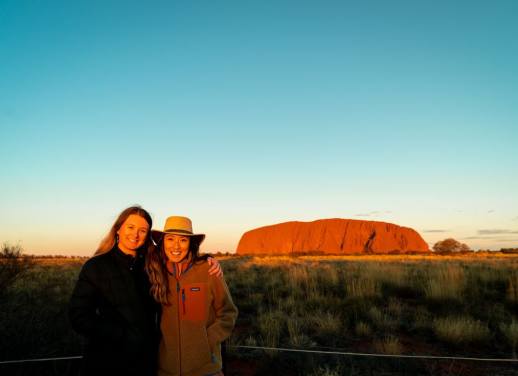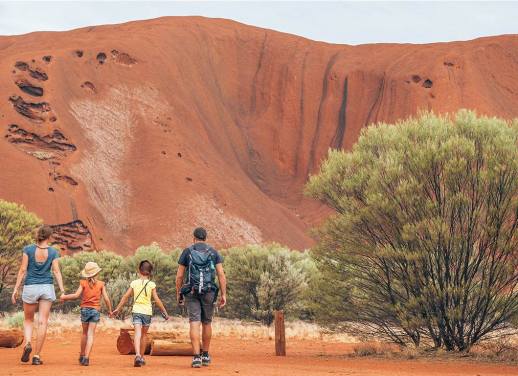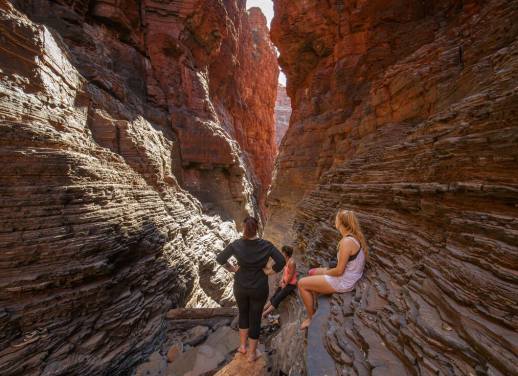It was just before 10am, but as a Melburnian used to the chilly weather, it already felt swelteringly hot as I sipped my coffee and waited for Janbal Gallery to open.
I was in Mossman in Tropical North Queensland, on Intrepid’s 5-day Daintree Retreat, and was about to begin an art workshop with a local Aboriginal artist. The morning would end up being one of the highlights of the entire, highlight-filled trip.
As we walked inside the welcomingly air-conditioned gallery, our host Brian Swindley, or Binna, as he is more commonly known, introduced himself to us as the artist and owner. Binna was born hearing impaired and his nickname means deaf in the local Kuku Yalanji language, but as he is an avid lip-reader, chatting with him and following his instructions during the workshop was easy.
VISIT JANBAL GALLERY YOURSELF ON INTREPID’S 5-DAY DAINTREE RETREAT
“We have lots of travellers come from all over the world to visit us at Janbal Gallery. I was born deaf and I hope people have a great experience here learning from a hearing-impaired Aboriginal person,” explains Binna as we take our seats around a large wooden table.
Janbal Gallery gets its name from the word quandong in Kuku Yalanji. A quandong is a native Australian fruit, but it was also the language name Binna’s mother went by.
“We named the gallery after her, because this was actually my Mum and Dad’s house,” says Binna.
“My Mum loved to paint and back in the 1980s Mum and I just used to have paintings scattered everywhere. Then in 1989 I studied art at college in Cairns. Mum originally did very traditional artwork, but she’d keep asking me to draw different animals for her with lines, until I said, ‘I am not going to be here all the time to draw for you, you’re going to have to learn to draw for yourself!’. So, I brought some canvases home for Mum to paint on and I would show her what I was learning in college and that really changed her painting style.”
READ MORE: THE HEART OF THE DAINTREE – ECO-TOURISM IN THE WORLD’S OLDEST RAINFOREST
Over the years, Binna had a variety of jobs in addition to painting. He spent time working at Mossmon Gorge, a rainforest area in the Daintree National Park. Here he would find rainforest bush fruits and use them as inspiration for paintings. He also worked in the hospitality industry, but ultimately realised that if he wanted to focus on his art, he would have to dedicate all his time to it, which is why he opened Janbal Gallery in 2008. It’s not only a way to honour his Mum’s memory and showcase his and her artwork, but a way for him to share his culture with people from all around the world.
“The art workshops I run are about sharing culture,” explains Binna. “Sharing culture is about teaching the history of my people, the rainforest and where we are today. Around here used to all be rainforest and cassowaries and tree kangaroos and it’s all gone now. We have to move forward.”
READ MORE: 5 PLACES YOU DON’T WANT TO MISS IN FAR NORTH QUEENSLAND
As we’ve been talking, Binna has been mixing up different coloured paints, in preparation for us beginning the art workshop. He produces some sticks of bamboo and small squares of black canvas, which I eye slightly nervously as he talks.
“Follow me and see how you go!” he says enthusiastically, as I pick up my bamboo stick.
Binna explains how to use the two different ends of the stick to create different sized dots and different thicknesses of lines. It looks simple when he demonstrates, but as I quickly realise when I start painting, his hands are a lot steadier than mine.
“Today we’ll be painting cassowary footprints,” says Binna. “Cassowaries are very important to us, they eat the rainforest fruits and their poo helps recreate the forest. There aren’t many wild cassowaries left, so people need to concentrate and look after them because if we lose all the birds, that’s the end of it. They’re very big but they’re frightened.”
As we paint, Binna explains to us that the native Cassowary is his totem, so he would never hunt the bird that he describes as ‘the most beautiful, rainbow coloured bird in the world’. A totem is a spiritual emblem chosen by a First Nations person and it defines their role in traditional society, as well as their relationships with each other.
READ MORE: SEEING AUSTRALIA THROUGH THE EYES OF A TRADITIONAL CUSTODIAN OF THE LAND
As I try my best to copy Binna’s exact movements, I can see the cassowary footprints are created using a series of white dots and lines. Binna tells us that there are three main colours used by his people for painting: the ochre red which represents the land of the earth; the ochre yellow which represents the sun and the white for the water and rain.
Binna continues to share anecdotes about his Mum, the history of his people and his art, only pausing to offer sage advice like ‘don’t press too hard’, or ‘see – move the bamboo around like this when it drips too much paint’. When I realise that I have painted the white dots that represent water on the opposite side of the canvas to Binna he gives me a cheeky grin and says that it’s okay because I am not an artist and he’s sure I am very good at what I normally do.
Binna explains that one of the biggest challenges he’s faced when building up his business is that people who ring the gallery don’t always know that he is hearing impaired and can’t hear them on the phone. With the help of a business mentor, he’s worked to improve his website so that people can book an art workshop online or email him for information. This, coupled with a few exhibitions and publicity in local papers has meant his business is continually growing.
SIGN UP TO OUR NEWSLETTER FOR THE LATEST TRAVEL NEWS AND EXCLUSIVE OFFERS
“People want to meet me because I own this gallery a hundred percent as an Aboriginal artist and people can come here and I’ll get off my backside to give the customers a chance to talk to me and see my art. I welcome people myself in my language and offer to help them if they want it or let them walk around. And I explain to them about the artwork and the stories.”
At the end of the workshop we left Janbal Gallery with our finished artwork as a souvenir. As I write this, I’m looking up at the little square of canvas, sitting on the desk in my home office back in Melbourne. It might sound like a cliché, but it wasn’t the souvenir artwork that I treasure most from the workshop, but Binna’s willingness to open up and share his culture with a group of travellers from around the world.
Future travel awaits! You can take part in Janbal Gallery’s art workshop on Intrepid’s 5-day Daintree Retreat.
As an Australian-owned business, we acknowledge the Traditional Owners of Country throughout Australia and their continuing connection to land, waters and community. We pay our respects to them and their cultures, and to their Elders past, present and future.
All images by Patrick O’Neill.

